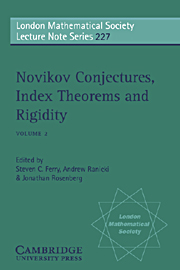Book contents
- Frontmatter
- Contents
- Contents, Volume 1
- Preface, The Editors
- Research and Survey Papers
- Proper affine isometric actions of amenable groups
- Bounded K-theory and the assembly map in algebraic K-theory
- On the rigidity of the index on open manifolds
- Remarks on Steenrod homology
- Epsilon surgery theory
- On the coarse Baum-Connes conjecture
- Exotic index theory and the Novikov conjecture
- Bounded and continuous control
- On the homotopy invariance of the boundedly controlled signature of a manifold over an open cone
- 3-manifolds and PD(S)-groups
- Orthogonal complements and endomorphisms of Hilbert modules and C*-elliptic complexes
- Assembly
On the homotopy invariance of the boundedly controlled signature of a manifold over an open cone
Published online by Cambridge University Press: 07 May 2010
- Frontmatter
- Contents
- Contents, Volume 1
- Preface, The Editors
- Research and Survey Papers
- Proper affine isometric actions of amenable groups
- Bounded K-theory and the assembly map in algebraic K-theory
- On the rigidity of the index on open manifolds
- Remarks on Steenrod homology
- Epsilon surgery theory
- On the coarse Baum-Connes conjecture
- Exotic index theory and the Novikov conjecture
- Bounded and continuous control
- On the homotopy invariance of the boundedly controlled signature of a manifold over an open cone
- 3-manifolds and PD(S)-groups
- Orthogonal complements and endomorphisms of Hilbert modules and C*-elliptic complexes
- Assembly
Summary
Introduction
The theorem of Novikov, that the rational Pontrjagin classes of a smooth manifold axe invariant under homeomorphisms, was a landmark in the development of the topology of manifolds. The geometric techniques introduced by Novikov were built upon by Kirby and Siebenmann in their study of topological manifolds. At the same time the problem was posed by Singer of developing an analytical proof of Novikov's original theorem.
The first such analytic proof was given by Sullivan and Teleman, building on deep geometric results of Sullivan which showed the existence and uniqueness of Lipschitz structures on high-dimensional manifolds. (It is now known that this result is false in dimension 4 – see.) However, the geometric techniques needed to prove Sullivan's theorem are at least as powerful as those in Novikov's original proof. For this reason, the Sullivan-Teleman argument (and the variants of it that have recently appeared) do not achieve the objective of replacing the geometry in Novikov's proof by analysis.
In an unpublished but widely circulated preprint, one of us (S.W.) suggested that this objective might be achieved by the employment of techniques from coarse geometry. A key part in the proposed proof is played by a certain homotopy invariance property of the ‘coarse analytic signature’ of a complete Riemannian manifold. We will explain in section 2 below what the coarse analytic signature is, in what sense it is conjectured to be homotopy invariant, and how Novikov's theorem should follow from the conjectured homotopy invariance. In section 3 we will prove the homotopy invariance modulo 2-torsion in the case that the control space is a cone on a finite polyhedron.
- Type
- Chapter
- Information
- Novikov Conjectures, Index Theorems, and Rigidity , pp. 285 - 300Publisher: Cambridge University PressPrint publication year: 1995
- 3
- Cited by

